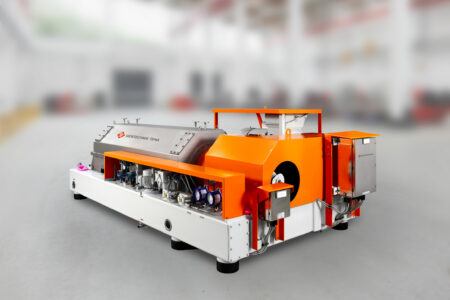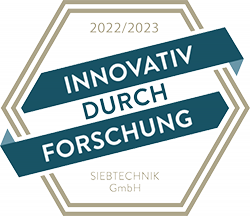Screen scroll centrifuge CONTURBEX
The CONTURBEX is a continuously operating, filtering centrifuge with a very wide range of applications.
Sodium carbonate (Na₂CO₃) or soda ash is a white crystalline powder with high water solubility and an alkaline pH.
Depending on temperature and pressure, it crystallizes in different crystal systems – from anhydrous soda ash to decahydrate, known as mineral or crystal soda ash.
Because of its versatile properties, soda ash is used in a wide range of industries and in the home.
Sodium carbonate (Na₂CO₃) can occur in seven different crystal structures. Each has a slightly different arrangement of atoms and molecules, which can result in different physical properties. Soda is one of these seven chemical forms of sodium carbonate. There is also anhydrous sodium carbonate (Na₂CO₃, Mineral: Natrite), sodium carbonate monohydrate (Na₂CO₃·H₂O, Mineral: Thermonatrite), sodium calcium carbonate dihydrate (Na₂Ca(CO₃)₂·2H₂O, Mineral: Pirssonite), sodium calcium carbonate pentahydrate (Na₂Ca(CO₃)₂·5H₂O, Mineral: Gaylussite), sodium carbonate heptahydrate (Na₂CO₃·7 H₂O) and sodium carbonate hydrogen carbonate dihydrate (Na(HCO₃)·Na₂CO₃·2H₂O, Mineral: Trona).
Soda ash is an indispensable part of our daily lives. From cleaning to manufacturing to environmental technology, soda ash is a versatile helper with a wide range of practical applications.
Soda ash is an effective and environmentally friendly cleaning agent that removes stubborn dirt, grease and stains from a wide variety of surfaces. Soda ash is used in many chemical processes, including the production of acids, alkalis and other chemical compounds. In the manufacture of soaps and detergents, soda is used as an alkali source to increase the cleaning power.
In the iron and glass industries, for example, it is used as a flux. Soda lowers the melting temperature of sand or quartz sand and other glass raw materials and promotes the formation of a homogeneous glass mass. This reduces melting time and makes glass production more economical. In the iron and steel industry, sodium carbonate is used as a flux in the melting of pig iron or in the production of steel.
It is used to desulfurize pig iron and remove impurities such as phosphorus, allowing iron or steel to be melted at lower temperatures, reducing energy consumption and making the process more efficient. In electroplating, sodium carbonate is used as an electrolyte component to coat or polish metals.
It is also used in exhaust gas purification (e.g. flue gas desulfurization) and water treatment. In water treatment, sodium carbonate is used to soften water by binding excess hardness builders such as calcium and magnesium ions. In addition, sodium carbonate is used in some environmental applications, such as treating contaminated soil and neutralizing acidic water.
Sodium carbonate is a component in the production of paper and paperboard, as it dissolves the cellulose and bleaches the paper fibers. It is also used in some paper and board recycling processes to remove ink and dye residues and prepare the paper for reuse.
Soda ash is produced in several ways, but the two most common methods are the Solvay process and the trona ore process. Of the total production, 70-80% of soda ash is produced by the conversion of common salt (NaCl). The remaining 20-30% is extracted from naturally occurring soda deposits.
Trona is a natural mineral rich in sodium carbonate (Na₂CO₃) and sodium bicarbonate (NaHCO₃). It is formed by the evaporation of alkaline or salt lakes and is found in large quantities in some regions of the world. Trona is often used as a natural source of soda ash and is mined. To produce pure soda ash with sodium hydrogen carbonate (sodium bicarbonate) as an intermediate product, the mined deposits are recrystallized prior to further processing due to impurities in the source minerals and converted to purified soda ash free of crystalline water by calcination at 200°C.
The Solvay process is the most widely used method for the industrial production of soda ash. In this multi-step process, the by-product sodium hydrogen carbonate is separated from an ammonium chloride solution and then calcined, i.e. heated at a high temperature (> 200°C). During this process, it decomposes into sodium carbonate (soda), releasing carbon dioxide and water. The sodium carbonate can be obtained as a powder by filtration, centrifugation and drying.

Solvay process for the production of sodium carbonate
Our screen scroll centrifuges are used in the extraction of soda from natural deposits as well as in chemical processes to separate solids after washing and crystallization.
SIEBTECHNIK TEMA centrifuges are specially optimized for the respective separation task. When selecting materials, austenitic and ferritic stainless steels have proven themselves in centrifuge construction for applications subject to normal stresses.
For processes in which abrasive materials are processed, the centrifuges must be provided with effective wear protection. Starting with hard coal processing, we have been continuously developing wear protection systems since 1922.
Our centrifuges can be equipped with highly developed wear protection systems made of e.g. tungsten carbide, Stellite® or ceramic tiles, to name but a few. Rubber coatings or matrix coatings have also proven themselves in various applications.
If required, our engineers develop new and efficient solutions in coating, bonding and joining technology for our customers worldwide.
Centrifuge components must not only withstand high forces, but also process-related stresses such as corrosion, wear and high temperatures. Cost and availability of materials also play an important role. Our customers select the necessary product-contacting materials according to these very specific requirements.
Duplex and high-alloy stainless steels, Hastelloy® and titanium materials for a wide variety of processes and stresses are part of our daily business in centrifuge construction. Our quality management has developed very detailed and cost effective processes for design, manufacturing processes and component testing based on European guidelines.
Typical sheet metal and forging materials for centrifuge wetted components include

The CONTURBEX is a continuously operating, filtering centrifuge with a very wide range of applications.

The SIEBTECHNIK TEMA SHS pusher centrifuge has established itself and proven itself as a modern high-performance unit in many industries.

Our decanters are individual, functional and versatile. They offer highly efficient separation of even the finest solids with almost complete clarification of the liquid phase.

Find the right contact for your region.
We have the right solution for every task. And if not, we’ll work with you to find one. Get in touch with us!
Our specialists will be happy to advise you individually on site or remotely, and are available to answer any questions you may have. Send us a message using our
